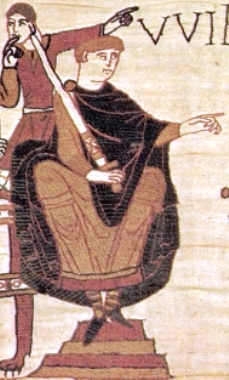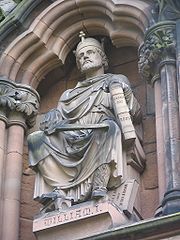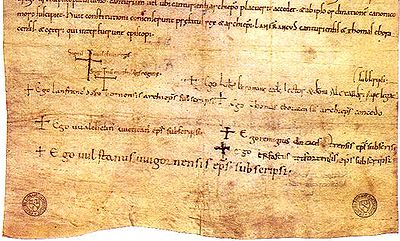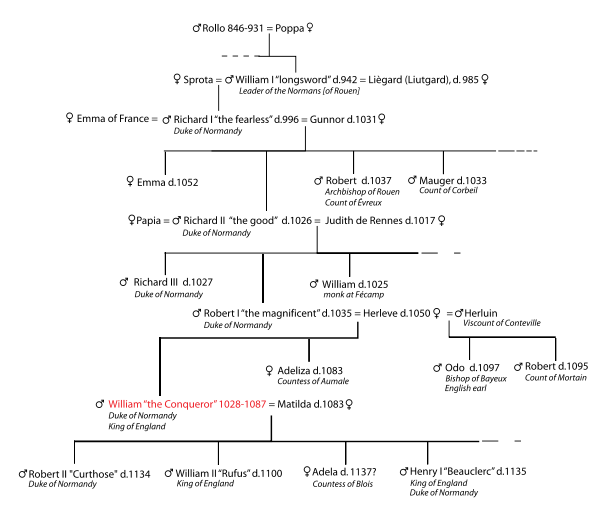
William the Conqueror
About this schools Wikipedia selection
This wikipedia selection has been chosen by volunteers helping SOS Children from Wikipedia for this Wikipedia Selection for schools. Visit the SOS Children website at http://www.soschildren.org/
| William I | |
|---|---|
| King of the English | |
 |
|
| The Duke of Normandy in the Bayeux Tapestry | |
| Reign | 25 December 1066 – 9 September 1087 |
| Coronation | 25 December 1066 |
| Predecessor | England: Edgar Ætheling (uncrowned), Harold II Normandy: Robert I the Magnificent |
| Successor | England: William II Rufus Normandy: Robert II Curthose, Duke of Normandy |
| Spouse | Matilda of Flanders |
| Issue | |
| Robert II, Duke of Normandy Richard, Duke of Bernay William II of England Adela, Countess of Blois Henry I of England |
|
| Father | Robert the Magnificent |
| Mother | Herlette of Falaise |
| Burial | Saint-Étienne de Caen, France |
William I of England ( 1027 – 9 September 1087), also known as William the Conqueror (French: Guillaume le Conquérant), was Duke of Normandy from 1035 and King of England from 1066 to his death.
To claim the English crown, William invaded England in 1066, leading an army of Normans to victory over the Anglo-Saxon forces of Harold Godwinson (who died in the conflict) at the Battle of Hastings, and suppressed subsequent English revolts in what has become known as the Norman Conquest.
His reign, which brought Norman culture to England, had an enormous impact on the subsequent course of England in the Middle Ages. In addition to political changes, his reign also saw changes to English law, a programme of building and fortification, changes to the vocabulary of the English language, and the introduction of continental European feudalism into England.
As Duke of Normandy, he is known as William II. He was also, particularly before the conquest, known as William the Bastard.
Early life
William was born in Falaise, Normandy, the illegitimate and only son of Robert I, Duke of Normandy, who named him as heir to Normandy. His mother, Herleva (among other names), who later had two sons to another father, was the daughter of Fulbert, most probably a local tanner. He also had a sister, Adelaide of Normandy, also through Robert and Herleva. Later in life the enemies of William are said to have commented derisively that William stank like a tanner shop, and the residents of besieged Alençon hung skins from the city walls to taunt him.
William is believed to have been born in either 1027 or 1028, and more likely in the autumn of the later year. He was born the grandnephew of Queen Emma of Normandy, wife of King Ethelred the Unready and later of King Canute the Great.
Duke of Normandy
By his father's will, William succeeded him as Duke of Normandy at age eight in 1035 and was known as Duke William of Normandy (French: Guillaume, duc de Normandie; Latin: Guglielmus Dux Normanniae). Plots by rival Norman noblemen to usurp his place cost William three guardians, though not Count Alan of Brittany, who was a later guardian. William was supported by King Henry I of France, however. He was knighted by Henry at age 15. By the time William turned 19 he was successfully dealing with threats of rebellion and invasion. With the assistance of Henry, William finally secured control of Normandy by defeating rebel Norman barons at Caen in the Battle of Val-ès-Dunes in 1047, obtaining the Truce of God, which was backed by the Roman Catholic Church.
Against the wishes of Pope Leo IX, William married Matilda of Flanders in 1053 in the Cathedral of Notre Dame at Eu, Normandy ( Seine-Maritime). At the time, William was about 24 years old and Matilda was 22. William is said to have been a faithful and loving husband, and their marriage produced four sons and six daughters. In repentance for what was a consanguine marriage (they were distant cousins), William donated St-Stephen's church (l' Abbaye-aux-Hommes) and Matilda donated Sainte-Trinité church ( Abbaye aux Dames).
Feeling threatened by the increase in Norman power resulting from William's noble marriage, Henry I attempted to invade Normandy twice (1054 and 1057), without success. Already a charismatic leader, William attracted strong support within Normandy, including the loyalty of his half-brothers Odo of Bayeux and Robert, Count of Mortain, who played significant roles in his life. Later, he benefitted from the weakening of two competing power centers as a result of the deaths of Henry I and of Geoffrey II of Anjou, in 1060. In 1062 William invaded and took control of the county of Maine, which had been a fief of Anjou.
English succession
Upon the death of the childless Edward the Confessor, the English throne was fiercely disputed by three claimants -- William, Harold Godwinson, the powerful Earl of Wessex, and the Viking King Harald III of Norway, known as Harald Hadrada. William had a tenuous blood claim, through his great aunt Emma (wife of Ethelred and mother of Edward). William also contended that Edward, who had spent much of his life in exile in Normandy during the Danish occupation of England, had promised William the throne when William visited Edward in London in 1052. Finally, William claimed that Harold had pledged allegiance to him in 1064. William had rescued the shipwrecked Harold from the count of Ponthieu, and together they had defeated Conan II, Count of Brittany. On that occasion, William knighted Harold, and deceived him by having him swear loyalty to William over the concealed bones of a saint.
In January 1066, however, in accordance with Edward's last will and by vote of the Witenagemot, Harold Godwinson was crowned King by Archbishop Aldred. Immediately the new monarch raised a large fleet of ships and mobilized a force of militia, arranging these around the coasts to anticipate attack from several directions. Harold, after defeating his brother Tostig Godwinson and Harald Hardrada in the north, marched his army 241 miles to meet the invading William in the south. Their forces met at what is now called the Battle of Hastings where it is said that Harold Godwinson was shot through the eye with an arrow and died.
Norman invasion
Meanwhile, William submitted his claim to the English throne to Pope Alexander II, who sent him a consecrated banner in support. Then, William organized a council of war at Lillebonne and openly began assembling an army in Normandy. Offering promises of English lands and titles, he amassed at Saint-Valery-sur-Somme a considerable invasion force of 600 ships and 7,000 men, consisting of Normans, French mercenaries, and numerous foreign knights. Initially, Harold opposed William with a large army on the south coast of England and a fleet of ships guarding the English Channel.
Fortuitously, however, William's crossing was delayed by weeks of unfavourable winds. William managed to keep his army together during the wait, but Harold's was diminished by dwindling supplies and falling morale with the arrival of the harvest season. He also consolidated his ships in London, leaving the English Channel unguarded. Then came the news that Harald III of Norway, allied with Tostig, had landed ten miles from York.
Before Harold could return, the wind direction turned and William had crossed, landing his army at Pevensey Bay ( Sussex) on September 28. Then he moved to Hastings, a few miles to the east, where he built a prefabricated wooden castle for a base of operations. From there, he ravaged the hinterland and waited for Harold's return from the north.
Battle of Hastings
On October 13, William received news that the already weakened army led by Harold was approaching from London, and at dawn the next day, William left the castle with his army and advanced towards the enemy. Harold had taken a defensive position atop the Senlac Hill/Senlac ridge, about seven miles from Hastings, at present-day Battle, East Sussex.
The Battle of Hastings lasted all day. Although the numbers on each side were about equal, William had both cavalry and infantry, including many archers, while Harold had only foot soldiers and few if any archers. Along the ridge's border, formed as a wall of shields, the English soldiers at first stood so effectively that William's army was thrown back with heavy casualties. William rallied his troops, however -- reportedly raising his helmet, as shown in the Bayeux Tapestry, to quell rumors of his death. Meanwhile, many of the English had pursued the fleeing Normans on foot, allowing the Norman cavalry to attack them repeatedly from the rear as his infantry pretended to retreat further. Norman arrows also took their toll, progressively weakening the English wall of shields. A final Norman cavalry attack decided the battle irrevocably, resulting in the deaths of Harold, killed by an arrow in the eye, and two of his brothers, Gyrth and Leofwine Godwinson. At dusk, the English army made their last stand. By that night, the Norman victory was complete and the remaining English soldiers fled in fear.
March to London
For two weeks, William waited for a formal surrender of the English throne, but the Witenagemot proclaimed the quite young Edgar Ætheling instead, without coronation though. Thus, William's next target was London, approaching proudly through the important territories of Kent, via Dover and Canterbury, inspiring fear in the English. However, at London, William's advance was beaten back at London Bridge, and he decided to march westward and to storm London from the northwest. After receiving continental reinforcements, William crossed the Thames at Wallingford, and there he forced the surrender of Archbishop Stigand (one of Edgar's lead supporters), in early December. William reached Berkhamsted a few days later where Ætheling relinquished the English crown personally and the exhausted Saxon noblemen of England surrendered definitively. Although William was acclaimed then as English King, he requested a coronation in London. As William I, he was formally crowned on Christmas day 1066, in Westminster Abbey, by Archbishop Aldred.
English resistance
Although the south of England submitted quickly to Norman rule, resistance in the north continued for six more years until 1072. During the first two years, King William I suffered many revolts throughout England (Dover, western Mercia, Wales, Exeter). Also, in 1068, Harold's illegitimate sons attempted an invasion of the southwestern peninsula, but William defeated them.
For William I, the worst crisis came from Northumbria, which had still not submitted to his realm. In 1068, with Edgar Ætheling, both Mercia and Northumbria revolted. William could suppress these, but Edgar fled to Scotland where Malcolm III of Scotland protected him. Furthermore, Malcolm married Edgar's sister Margaret, with much éclat, stressing the English balance of power against William. Under such circumstances, Northumbria rebelled, besieging York. Then, Edgar resorted also to the Danes, who disembarked with a large fleet at Northumbria, claiming the English crown for their King Sweyn II. Scotland joined the rebellion as well. The rebels easily captured York and its castle. However, William could contain them at Lincoln. After dealing with a new wave of revolts at western Mercia, Exeter, Dorset, and Somerset, William defeated his northern foes decisively at the River Aire, retrieving York, while the Danish army swore to depart.
William then devastated Northumbria between the Humber and Tees rivers, with his Harrying of the North. This devastation included setting fire to the vegetation, houses and even tools to work the fields. He also burnt crops, killed livestock and sowed the fields and land with salt, to stunt growth. After this cruel treatment the land did not recover for more than 100 years. The region ended up absolutely deprived, losing its traditional autonomy towards England. However it may have stopped future rebellions, scaring the English people in obedience. Then, the Danish king disembarked in person, readying his army to restart the war, but William suppressed such threat with a payment of gold. Subsequently in 1071, William defeated the last rebel focus of the north through an improvised pontoon, subduing the Ely island at which the Danes had gathered. In 1072, he invaded Scotland, defeating Malcolm and gaining a temporary peace. In 1074, Edgar Ætheling submitted definitively to William.
In 1075, during William's absence, the Revolt of the Earls was confronted successfully by Odo. In 1080, William sent his half brothers Odo and Robert, who stormed Northumbria and Scotland, respectively. Eventually, the Pope protested against the excessive mistreatment which had been exerted by the Normans against the English people. Indeed, until overcoming all rebellions, William had conciliated with the English church although he persecuted it ferociously afterward.
Reign in England
Events
As was usual for his descendants also William spent much time (11 years, since 1072) at Normandy, ruling the islands through his writs. Nominally still a vassal state, owing its entire loyalty to the French king, Normandy arose suddenly as a powerful region, alarming the other French Dukes which reacted by attacking it persistently. As Duke of Normandy, William was obsessed with conquering Brittany, and the French King Philip I admonished him. Nonetheless, in 1086, William invaded Brittany, forcing the flight of the Duke Alan IV. A peace treaty was signed, and William betrothed Constance (who was poisoned a few years later) to Alan.
The mischief of William's elder son Robert arose after a prank of his brothers William and Henry, who doused him with filthy water. The situation became a large scale Norman rebellion. Only with King Philip's additional military support William was able to confront Robert, who had based at Flanders. During the battle in 1079, William was unhorsed and wounded by Robert, who lowered his sword only after recognizing him. The embarrassed William returned to Rouen, abandoning the expedition. In 1080, Matilda reconciled both, and William revoked Robert's inheritance.
Odo caused many troubles to William, and he was imprisoned in 1082, losing his English estate and all royal functions, except the religious ones. In 1083, Matilda died, and William became more tyrannical over his realm.
Reforms
William initiated many major changes. He increased the function of the traditional English shires (autonomous administrative regions), which he brought under central control; he decreased the power of the earls by restricting them to one shire apiece. All administrative functions of his government remained fixed at specific English towns, except the court itself; they would progressively strengthen, and the English institutions became amongst the most sophisticated in Europe. In 1085, in order to ascertain the extent of his new dominions and to improve taxation, William commissioned all his counselors for the compilation of the Domesday Book, which was published in 1086. The book was a survey of England's productive capacity similar to a modern census.
William also ordered many castles, keeps, and mottes, among them the Tower of London's foundation (the White Tower), which were built throughout England. These ensured effectively that the many rebellions by the English people or his own followers did not succeed.
His conquest also led to French (especially, but not only, the Norman French) replacing English as the language of the ruling classes for nearly 300 years. Furthermore, the original Anglo-Saxon cultural influence of England became mingled with the Norman one; thus the Anglo-Norman culture came into being.
William is said to have eliminated the native aristocracy in as little as four years. Systematically, he despoiled those English aristocrats who either opposed the Normans or who died without issue. Thus, most English estates and titles of nobility were handed to the Norman noblemen. Many English aristocrats fled to Flanders and Scotland; others may have been sold into slavery overseas. Some escaped to join the Byzantine Empire's Varangian Guard, and went on to fight the Normans in Sicily. By 1070, the indigenous nobility had ceased to be an integral part of the English landscape, and by 1086, it maintained control of just 8% of its original land-holdings. However, to the new Norman noblemen, William handed the English parcels of land piecemeal, dispersing these wide. Thus nobody would try conspiring against him without jeopardizing their own estates within the so unstable England. Effectively, this strengthened William's political stand as a monarch.
William also seized and depopulated many miles of land (36 parishes), turning it into the royal New Forest region to support his enthusiastic enjoyment of hunting.
Death, burial, and succession
In 1087 in France, William burned Mantes (50 km west of Paris), besieging the town. However, he fell off his horse, suffering fatal abdominal injuries by the saddle pommel. On his deathbed, William divided his succession for his sons, sparking strife between them. Despite William's reluctance, his combative elder son Robert received the Duchy of Normandy, as Robert II. William Rufus (his third son) was next English king, as William II. William's youngest son Henry received 5,000 silver pounds, which would be earmarked to buy land. He also became King Henry I of England after William II died without issue. While on his deathbed, William pardoned many of his political adversaries, including Odo.
William died at age 59 at the Convent of St Gervais near Rouen, France, on 9 September 1087. William was buried in the Abbaye-aux-Hommes, which he had erected, in Caen, Normandy.
According to some sources, a fire broke out during the funeral; the original owner of the land on which the church was built claimed he had not been paid yet, demanding 60 shillings, which William's son Henry had to pay on the spot; and, in a most unregal postmortem, William's corpulent body would not fit in the stone sarcophagus.
William's grave is currently marked by a marble slab with a Latin inscription; the slab dates from the early 19th century. The grave was defiled twice, once during the French Wars of Religion, when his bones were scattered across the town of Caen, and again during the French Revolution. Following those events, only William's left femur remains in the tomb.
Legacy
William's invasion was the last time that England was successfully conquered by a foreign power. Although there would be a number of other attempts over the centuries, the best that could be achieved would be excursions by foreign troops, such as the Raid on the Medway during the Second Anglo-Dutch War, but no actual conquests such as William's.
As Duke of Normandy and King of England he passed the titles on to his descendants. Other territories would be acquired by marriage or conquest and, at their height, these possessions would be known as the Angevin Empire.
They included many lands in France, such as Normandy and Aquitaine, but the question of jurisdiction over these territories would be the cause of much conflict and bitter rivalry between England and France, which took up much of the Middle Ages, including the Hundred Years War and, some might argue, continued as far as the Battle of Waterloo of 1815.
Physical appearance
No authentic portrait of William has been found. Nonetheless, he was depicted as a man of fair stature with remarkably strong arms, "with which he could shoot a bow at full gallop". William showed a magnificent appearance, possessing a fierce countenance. He enjoyed an excellent health; nevertheless his noticeable corpulence augmented eventually so much that French King Philip I commented that William looked like a pregnant woman.
Ancestors
|
|
|
|
|
|
|
|
|
|
|
|
|
|
|
|
|
|
|
|
16. William I, Duke of Normandy | |||||||||||||||
|
|
||||||||||||||||
|
|
|
|
|
|
||||||||||||
|
|
8. Richard I, Duke of Normandy |
|
||||||||||||||
|
|
||||||||||||||||
|
|
|
|
|
|
|
|
|
|||||||||
|
|
17. Sprota | |||||||||||||||
|
|
||||||||||||||||
|
|
|
|
|
|
||||||||||||
|
|
4. Richard II, Duke of Normandy |
|
||||||||||||||
|
|
||||||||||||||||
|
|
|
|
|
|
|
|
|
|
|
|
||||||
|
|
9. Gunnora, Duchess of Normandy |
|
||||||||||||||
|
|
||||||||||||||||
|
|
|
|
|
|
|
|
|
|||||||||
|
|
2. Robert I, Duke of Normandy |
|
||||||||||||||
|
|
||||||||||||||||
|
|
|
|
|
|
|
|
|
|
|
|
|
|
|
|||
|
|
20. Judicael Berengar | |||||||||||||||
|
|
||||||||||||||||
|
|
|
|
|
|
||||||||||||
|
|
10. Conan I of Rennes |
|
||||||||||||||
|
|
||||||||||||||||
|
|
|
|
|
|
|
|
|
|||||||||
|
|
21. Gerberge | |||||||||||||||
|
|
||||||||||||||||
|
|
|
|
|
|
||||||||||||
|
|
5. Judith of Brittany |
|
||||||||||||||
|
|
||||||||||||||||
|
|
|
|
|
|
|
|
|
|
|
|
||||||
|
|
22. Geoffrey I of Anjou | |||||||||||||||
|
|
||||||||||||||||
|
|
|
|
|
|
||||||||||||
|
|
11. Ermengarde of Anjou |
|
||||||||||||||
|
|
||||||||||||||||
|
|
|
|
|
|
|
|
|
|||||||||
|
|
23. Adele of Meaux | |||||||||||||||
|
|
||||||||||||||||
|
|
|
|
|
|
||||||||||||
|
|
1. William I of England |
|
||||||||||||||
|
|
||||||||||||||||
|
|
|
|
|
|
|
|
|
|
|
|
|
|
|
|
|
|
|
|
6. Fulbert of Falaise |
|
||||||||||||||
|
|
||||||||||||||||
|
|
|
|
|
|
|
|
|
|
|
|
||||||
|
|
3. Herleva |
|
||||||||||||||
|
|
||||||||||||||||
|
|
|
|
|
|
|
|
|
|
|
|
|
|
|
|||
Descendants
William is known to have had nine children, though Agatha, a tenth daughter who died a virgin, appears in some sources. Several other unnamed daughters are also mentioned as being betrothed to notable figures of that time. Despite rumours to the contrary (such as claims that William Peverel was a bastard of William) there is no evidence that he had any illegitimate children,
- Robert Curthose (1054–1134), Duke of Normandy, married Sybil of Conversano, daughter of Geoffrey of Conversano.
- Richard (c. 1055 – c. 1081), Duke of Bernay, killed by a stag in New Forest.
- Adeliza (or Alice) (c. 1055 – c. 1065), reportedly betrothed to Harold II of England.
- Cecilia (or Cecily) (c. 1056 – 1126), Abbess of Holy Trinity, Caen.
- William "Rufus" (c. 1056 – 1100), King of England.
- Agatha (c. 1064 – 1079), betrothed to Alfonso VI of Castile.
- Constance (c. 1066 – 1090), married Alan IV Fergent, Duke of Brittany; poisoned, possibly by her own servants.
- Adela (c. 1067 – 1137), married Stephen, Count of Blois.
- Henry "Beauclerc" (1068–1135), King of England, married Edith of Scotland, daughter of Malcolm III, King of the Scots. His second wife was Adeliza of Leuven.
Fictional depictions
William I has appeared as a character in only a few stage and screen productions. The one-act play A Choice of Kings by John Mortimer deals with his deception of Harold after the latter's shipwreck. Julian Glover portrayed him in a 1966 TV adaptation of this play in the ITV Play of the Week series.
William has also been portrayed on screen by Thayer Roberts in the film Lady Godiva of Coventry (1955), John Carson in the BBC TV series Hereward the Wake (1965), and Michael Gambon in the TV drama Blood Royal: William the Conqueror (1990).
On a less serious note, he has been portrayed by David Lodge in an episode of the TV comedy series Carry On Laughing entitled "One in the Eye for Harold" (1975), James Fleet in the humorous BBC show The Nearly Complete and Utter History of Everything (1999), and Gavin Abbott in an episode of the British educational TV series Historyonics entitled "1066" (2004).



